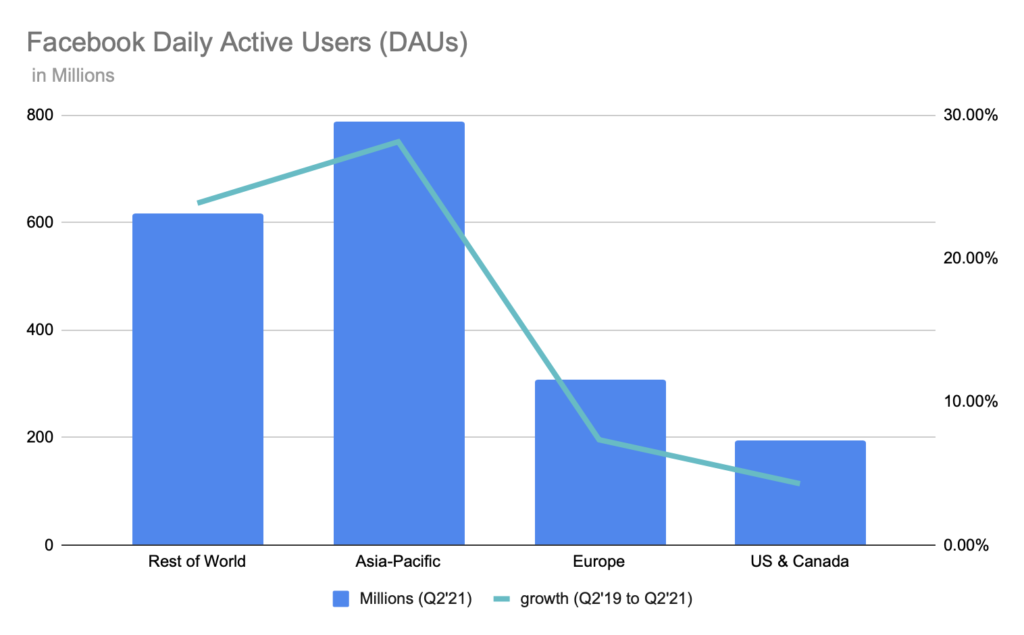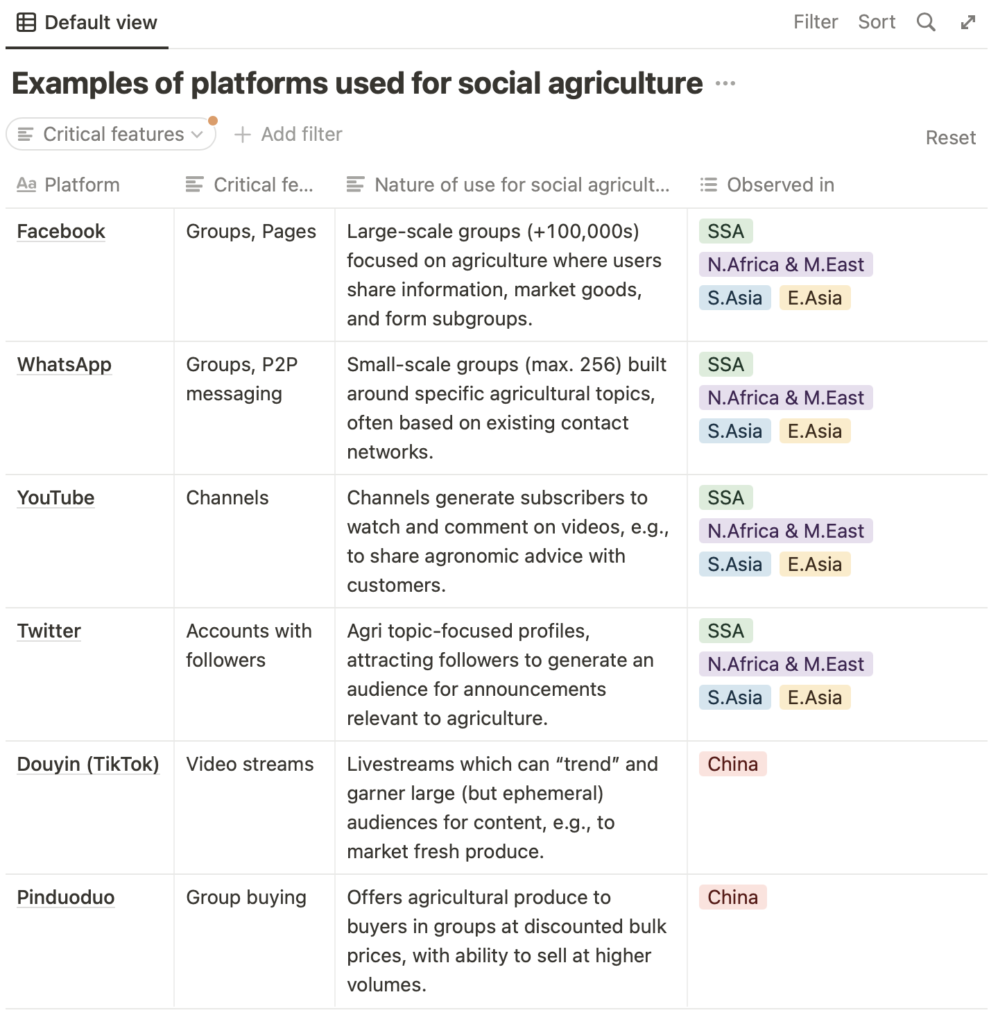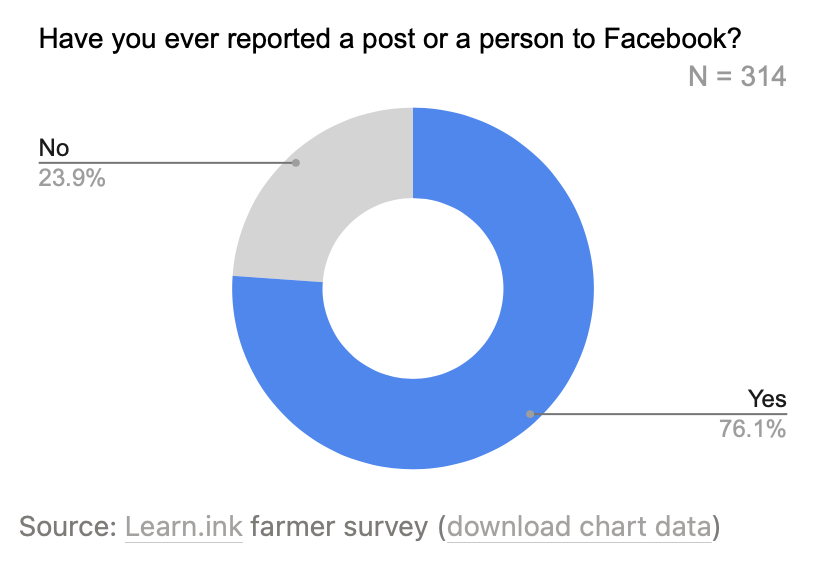Social Agriculture Ecosystem Report
Social Agriculture Reports
Report sections
This report is part of an overall research study on social agriculture in Kenya and will be followed by research in Ghana and Nigeria.
Acknowledgements
This report was written by Adam Wills, with guidance from Emrys Schoemaker and Jonathan Donner from Caribou Digital, and support from Kilimo Source and Habitus Insight. Special thanks to Robyn Read at the Mastercard Foundation for support and enthusiasm throughout the process.
For questions about this report, please contact Adam Wills at Adam@Learn.ink.
For questions about the social agriculture research, please contact Emrys Schoemaker at emrys@cariboudigital.com.
This report was produced by Learn.Ink, together with Kilimo Source, Habitus Insight, and Caribou Digital, in partnership with the Mastercard Foundation.
The views presented in this paper are those of the authors and do not necessarily represent the views of the Mastercard Foundation.
Recommended Citation
Learn.ink and Caribou Digital. The Ecosystem of “Social Agriculture.” Farnham, Surrey, United Kingdom: Caribou Digital Publishing, May 2022. www.platformlivelihoods.com/social-agriculture- ecosystem-report/.
The Ecosystem of “Social Agriculture”
Social agriculture refers to a set of practices that support agricultural livelihoods—including information exchange, support mechanisms, and markets—based on the use of social media platforms in countries with a high proportion of their workforce in agriculture. This report asks the questionWhat is “social agriculture” and why should we care? There are numerous examples of people engaged in these practices around the world—from livestock social media sellers in Egypt, to 100,000+ strong Facebook Farming Info groups in Kenya, to multichannel farmer protest movements in India, to livestreaming pomegranate farmers in China.
When exploring The size of social agriculture globally, we find that hundreds of millions may already be actively engaged in social agriculture, and there is huge room for growth into the global agricultural workforce—especially in Sub-Saharan Africa and Southern Asia. Many practices of information exchange and marketing are visible in large social-media-based groups. We deep dive into Examining large-scale groups in social agriculture in Kenya to learn more—attempting to navigate from a macro-picture of global usage to a micro-picture of individual users’ posts to build a granular understanding of the practices in question. We flag critical constraints of major social media platforms by considering Some algorithms that underpin social agriculture, and also draw on fresh survey data to explore The experience of social agriculture from users in Kenya —drawing from the perspectives of farmers, agronomists, buyers and more.
Finally we compare The story of social versus digital agriculture in Sub-Saharan Africa, finding that the former may have already outpaced the latter in scale. We provide some recommendations for how new and existing efforts in digital agriculture — an area that has received significant funding over the last decade — might build on the organic successes of social agriculture.
Get a quick take of our findings in the deck below or dive into the report sections for more detailed findings.
This work is accompanied by a detailed literature review, a qualitative report drawn from in-depth interviews with farmers and others involved in social agriculture in Kenya, and a mini documentary and set of video shorts. With this body of work we hope to jump-start further research and engagement within and around social agriculture—aiming to catalyze the most effective and scalable digital solutions that positively impact the agricultural livelihoods that compose a substantial proportion of the world’s global workforce.
What is social agriculture?
We are observing a rapid surge in activity on social media platforms coming from farmers and others working in agriculture around the world, specifically in countries with a high proportion of the workforce in agriculture. We term this phenomenon ‘social agriculture’ and define it in the following way:
Social agriculture refers to a set of practices that support agricultural livelihoods—including agricultural information exchange, agricultural support mechanisms, and agricultural markets—based on the use of social media platforms in countries with a high proportion of their workforce in agriculture.
Three key aspects of social agriculture
We conducted a detailed literature review and gathered stories and examples of practices around the world relating to social agriculture. We found three distinct sets of practices that make up this new and rapidly growing phenomenon.
1) Agricultural information exchange
Agricultural information exchange is the process of requesting, gathering, analyzing, and disseminating information about prices, best practices, and other information relevant to agricultural practitioners.
2) Agricultural support mechanisms
Agricultural support mechanisms are organizations or groups that support each other as agricultural practitioners through a combination of peer-to-peer camaraderie, collective action, funding, and/or in-kind support.
3) Agricultural markets
Agricultural markets are places where buyers and sellers can meet to facilitate the exchange or transaction of goods and services relating to agriculture.
Some further notes on social agriculture
With an outline of the concept of ‘social agriculture’ in view, it’s worth stressing a few further points about our understanding of this phenomenon.
- We stress the term livelihoods insofar as it comprises the capabilities, material and social resources, and activities required for a person working in agriculture. Livelihoods is a concept broader than only the way social media supports commercial interactions within the agriculture sector.
- We are using a broad sense of “social media” which describes a set of digital platforms that allow users to create and exchange information, ideas, interests, and other forms of expression via virtual communities and networks. This covers services like Facebook, WhatsApp, YouTube, Instagram, TikTok, etc.
- We stress that many of the interesting practices we describe tend to unintentionally arise from the infrastructure and logic of social media platforms themselves. In other words, individuals working in agricultural are often re-purposing existing platform features to try and achieve the intended ‘ends’ of social agriculture, i.e. information exchange, buying/selling, etc.
- We often see the reinforcement of social capital as integral to the phenomenon of social agriculture. In other words, some of the early beneficiaries of the system (e.g. those receiving information) must later become benefactors (e.g. become information providers) for the many of these systems to work. In particular, information exchange and support mechanisms depend upon the culture of reciprocity between individuals in the social agriculture space.
Why is it important to define and discuss social agriculture?
Agriculture is still the driving livelihood in many of the world’s countries.
International Labour Organisation (ILO) data on the share of persons of working age engaged in agriculture shows the importance of agriculture to livelihoods in much of the world’s lower- and middle-income countries. In Kenya, agriculture still represents over 50% of the employed labor force. In India and Bangladesh, it is around 40%, and in the Philippines, Indonesia, and China it stands at around 25%. By comparison, in the USA and UK this figure is below 2%.
Social media is achieving massive scale in countries with high proportions of the labor force in agriculture.
The global population currently stands at 7.8 billion. In 2021 Facebook reported that 1.9 billion people logged into Facebook every day. As technology analyst Ben Evans notes, 90% of Facebook’s daily active users are now outside the USA. Most of these users come from those lower- to middle-income countries where agriculture remains a key driver of GDP and accounts for a large share of the labor force. Facebook’s data shows the platform’s usage outside North America and Europe has rocketed in recent years. (Notably, this does not even include data on WhatsApp or Instagram usage).
It’s difficult to overstate the importance of India as a market for Facebook. Facebook’s usage in Southern Asia’s largest country exceeds that of the US and UK combined. Assuming that most of India’s Facebook users are between 15 and 64 years of age, Facebook’s daily active user numbers suggest roughly one in three working-age people in India use Facebook every day. Given that 42% of India’s labor force is employed in agriculture, the intersection between social media and agriculture is a sheer inevitability.
So what does this intersection between social media use and agriculture actually look like? The next section includes examples that demonstrate the experience of social agriculture around the world.
Global examples of social agriculture
The associated literature review cites numerous examples from news reports and other sources that document agricultural practices on social media. These span marketing, information sharing, and support mechanisms. Some platforms and their typical use cases are listed below.
North Africa and the Middle East
In Egypt, traders turn to Facebook to market their livestock during the COVID-19 pandemic. The video below documents the practice of sharing videos and images of livestock in Facebook groups to generate sales, where an Egyptian livestock farmer claims “three quarters of all trade is now through the internet.” Similar large-scale Facebook groups that facilitate the buying and selling of livestock exist in India and East Africa. In a later section, we dig further into The experience of social agriculture from users in Kenya, generated from a survey of 300+ social media users working in agriculture. Among other things, this survey explores the use of social media for agricultural trading. A recent World Bank report also found that “in Iraq, as in Lebanon and Jordan, informal Facebook and WhatsApp groups are used sporadically for agri-food e-commerce.”
Sub-Saharan Africa
Facebook and WhatsApp have been used to create a multitude of groups centered around agriculture. Three example groups are shown below; two were started in Kenya and the other in Zambia. The combined membership of the three groups alone includes 100,000s of users (though many are members of multiple groups). These three groups only scratch the surface of the agricultural activity on Facebook.
The groups themselves facilitate information sharing, buying and selling, and much more. Some have noted that, while small-scale farmers are already organizing themselves in these groups, there are issues with the quality and accuracy of information being shared.
In the video above, Richard Hay (University of Pretoria) gives a Ted talk describing how farmers are sharing information in the “Small Scale Farmers” group, a pattern similar across all the groups showcased in this section.
Our research indicates that digital groups play a pivotal role in much of social agriculture. Facebook groups represent the largest of these global communities. Some of these groups are public, like the Dairy Farmers Kenya group seen to the right. However, the majority of these groups are private. Further, users in these groups often tend to be members of WhatsApp groups focused on farming. The multitude and reach of these groups is unclear, but we suspect that they are the critical driver of social agriculture in much of Africa and Asia (excluding China).
Understanding the nature of these groups warrants further research. To date, very little public data or research has been released concerning this area. See Examining large-scale groups in social agriculture in Kenya for a deeper investigation of this topic.


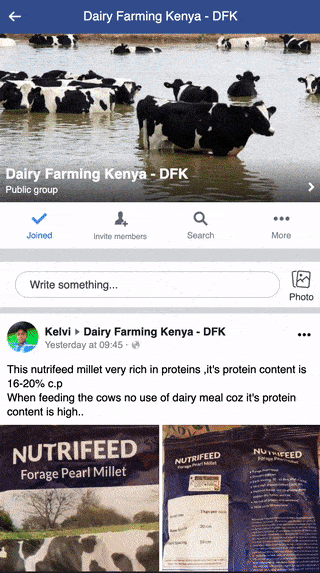
Southern Asia
India represents a massive population of farmers and social media users where recent protests put social media’s role into sharp focus. Just as in Africa, Facebook and WhatsApp groups are used at significant scale. For example, an organization called Hoy Amhi Shetkari (HAM) claims to have used a Facebook page and collection of groups “to get in touch with over 400,000 cane growers across the sugar producing states.” There are many groups on Facebook and WhatsApp that support information exchange and marketing. But it is the role that social media played in the farmer protests in 2020 that garnered recent media attention. As one outlet reported: “Protestors at the ongoing farmers’ agitation had said social media is crucial for their movement as it allowed them to share their views”.
This is a good example of the multifaceted use of social media platforms to support farming livelihoods. In this case, social media was used as an integral feature of a support mechanism to lobby for the rights of Indian farmers in a national protest.
Interestingly, across all these examples, spanning regions from Southern Asia to Sub-Saharan Africa to North Africa and the Middle East, the usage of groups and the dominance of Facebook and WhatsApp emerge. While other platforms like YouTube and Twitter have traction, Facebook’s platforms appear in examples over and over. This trend is widespread, until we come to China.
China
Facebook is banned across China. But there is a large and growing base of farmers using a combination of e-commerce and video streaming platforms. More than 100,000 farmers streamed 2.52 million sessions on Alibaba Group’s Taobao Live from March 2010 to March 2011. Douyin (TikTok’s Chinese twin) reported agricultural content creators with more than 10,000 followers rose sixfold in 2019–20 from the previous year.
One report describes “Brother Pomegranate“, an internet sensation with 7.3 million followers and 300 million yuan ($46 million) of sales in 2020. The report claims “he once sold 6 million yuan worth of pomegranates in 20 minutes.” Otherstories document the rise of farming streamers over the pandemic. In 2021 China’s Internet Network Information Center(CNNIC) reported:
“Rural e-commerce has been developing rapidly. As of the end of 2020, e-commerce had entered rural areas and achieved full coverage in 832 poverty-stricken counties. The national online retail sales in rural areas had increased from 180 billion yuan in 2014 to 1.79 trillion yuan in 2020. ‘Live streaming + e-commerce’ and other online shopping forms had been booming. Internet-based poverty alleviation had enabled new business forms to extend to rural areas. Mobile phones had become new agricultural tools and e-commerce new farming activities.”
How exactly does this distinctive form of social agriculture work in China? Watch the video below to learn more.

This is social commerce at a whole new level. Livestreaming is a mechanism for farmer “influencers” to gain attention, but it must be paired with e-commerce platforms. A technology platform called Pinduoduo connects farmers and consumers and has been one of the rising stars of China’s social agriculture boom. The platform pioneered a “group-buying” model, allowing individual consumers to team up in-app and collectively bulk buy goods from sellers. This approach should be distinguished from social commerce as it’s usually understood, i.e., using social media to assist online buying. This group buyer model is literally buying in groups. In the video below, Pinduoduo’s director for sustainability and agricultural impact explains this phenomenon.
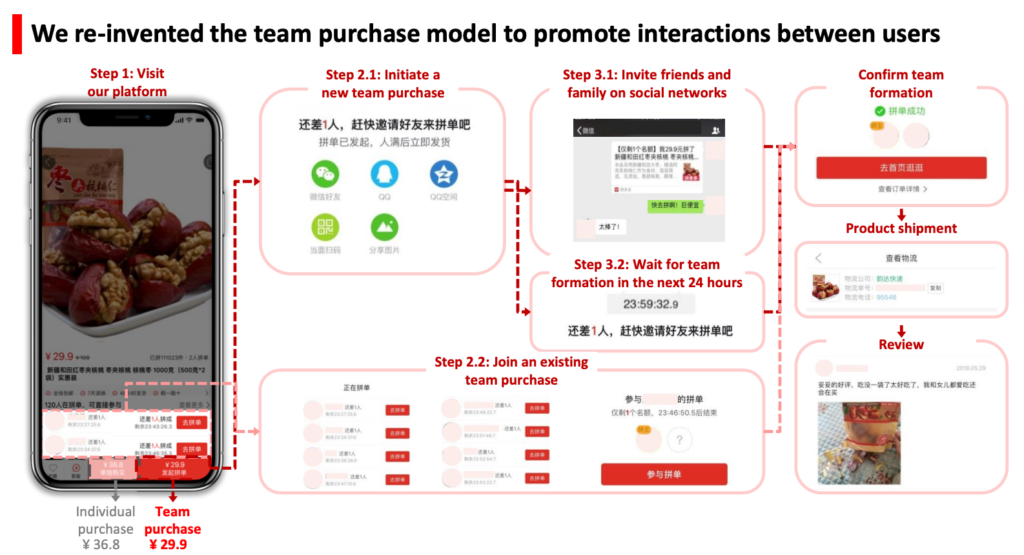
“[Users] were very willing to share news of these deals with their friends, and that drove rapid growth at an early stage… It helped us aggregate a large number of orders in a short period of time, so we could become a meaningful buyer of fresh produce. At one point we were influencing the market prices of fresh produce because we were such large buyers… Because we have this focus on being more social, on getting users first, having that word-of-mouth recognition gave farmers confidence [that] this is a platform they should be transacting with… Word spreads among farmers [too]. They may be in a village where others are selling the same thing, so if we are buying and they run out, they might ask their neighbour farmer [if] they want to sell to us.” – AgfunderNews (2021)
It appears social agriculture is exploding in China, albeit in different ways than in other major agricultural economies across Africa and Southern Asia. Further research might explore whether China’s “livestreaming + e-commerce” boom represents a bellwether for other countries or a distinct form of social agriculture unique to conditions in China.
Is the concept of social agriculture new?
This piece is accompanied by a detailed literature review which locates and assesses the coverage of the concept of ‘social agriculture’ in the existing literature. We found that social agriculture, as defined above, is not a term already defined elsewhere. However, it is a concept emerging at the intersections of other areas of study, most notably:
- Digital agriculture
- Social commerce
- Small-scale agriculture in developing countries
Some might assimilate this understanding of social agriculture with “digital agriculture.” The latter term has come to mean “digital platforms created by foreign and local tech firms … promoted as generating opportunities for farmers, shaping a vision of digitised agriculture.” This landscape of digital agriculture services sometimes labelled “ICT for agriculture (ICT4Ag)” or “digitalisation for agriculture (D4Ag)” has received significant attention and funding over the last decade. Insofar as these digital services and platforms have been intentionally created and funded to shape a vision of digitized agriculture, they clearly depart from the phenomenon of social agriculture described here, which arises from more generic platforms not specifically designed to facilitate agricultural activities. Digital agriculture is not the same as social agriculture.
Using Google Books’ Ngram Viewer for the terms “digital agriculture” and “social agriculture” shows how each phrase has occurred in a corpus of books over time. The term “digital agriculture” saw a notable uptake in use from the 2000s onwards, while “social agriculture” occurred sporadically over time (almost certainly with no relation to the definition proposed here, given that “social media” as a term was not popularized until the early 2000s).
Further questions to ask about social agriculture
Social agriculture is a phenomenon well on its way to the mainstream—if it is not firmly fixed there already. If social media platforms were not generally intended to be used for agricultural activities will there be problems with the growing dependence of agricultural livelihoods on social media? What are the risks and opportunities? Indeed, much of this “accidental learning from social” is seeping into the product design of China’s leading e-commerce platforms. Should other global platforms follow suit? How can the funding, work, and effort that has gone into digital agriculture be reconciled with social agriculture? What more can be learned about the experience of social agriculture from real farmers and other agricultural workers?
Of course, these questions exceed the scope of this report. Nevertheless, we hope to instigate a broader effort of investigation and interest in the area of social agriculture. Learning from and building upon this phenomenon is relevant across stakeholders from multiple sectors, including academic research, international development and the private sector.
To provide a foundation for the major questions around social agriculture, the next section explores the fundamental question of the scope of this phenomenon—what is The size of social agriculture globally?
How big is social agriculture globally?
This report’s initial discussion,What is “social agriculture” and why should we care?, identified examples of farmers and others engaged in social agriculture across regions of Sub-Saharan Africa, North Africa and the Middle East, and Southern and Eastern Asia. This section focuses on these global regions to estimate the number of people involved in social agriculture. Notably, this discussion does not include Latin America, because currently there are far fewer examples of social agriculture in action. However, this absence may be explained by the fact that our search was limited to English-speaking sources.
First a “Rest of World vs. China split” can be observed in these regions. China’s social agriculture is well established and predominantly based on technology platforms operating and designed for Chinese markets only (e.g., Pinduoduo and Douyin). In the rest of the world, Facebook and WhatsApp dominate usage. Publicly available data on the use of social media among farmers, or any of the above mentioned platforms, is sparse. Therefore, novel approaches are necessary to estimate the size of social agriculture across the regions identified. In particular:
- In China, we draw from statistical reports from China’s Internet Network Information Centre (CNNIC). These include useful survey data on the occupational structure of Chinese internet users, which split out “Laborers engaged in agriculture, forestry, animal husbandry, and fishery.”
- In the Rest of the World, we use Facebook’s advertising platform data on estimated audience size based on detailed targeting of users “interested in agriculture” as a proxy for the audience of those working in agriculture using social media.
Just how big is the audience “interested in agriculture”?
Facebook audience interested in agriculture
We built a dataset from Facebook’s Ad platform for a sample of all countries outside Latin America, Europe, and North America with at least15% of their labor force in agriculture. The following metric is defined from this data:
Facebook audience interested in agriculture (FBinAg audience): the estimated audience size for a country (or region) provided by the Facebook Ad platform when creating a new advertisement, where the ad uses the following detailed targeting settings: (1) users must live in the country (or region) selected; (2) users must be above 18 years of age; and (3) users must have an interest in “agriculture.”
The FBinAg audience serves as a rough estimate of social agriculture in the sample of countries with a higher proportion of the labor force working in Ag (min. 15%). Using previously collected data from Facebook’s Ad platform, this figure from 2018 and 2021 was compared. This approach will inevitably represent an overestimate of the total number of individuals involved in social agriculture (discussed more below). Nevertheless, we believe it provides a useful general estimation of the size of social agriculture in the regions highlighted in this report.
In 2018, the FBinAg audience in selected countries stood at just over 100 million. In 2021, this figure ballooned to over 220 million. Even if these estimates are restrained by a generous correction factor (e.g., cutting figures in half) to account for over-estimation of the actual population active in social agriculture, the scale of this audience is vast.
FB audience interested in ag in 2018: 109,771,420
FB audience interested in ag in 2021: 224,455,900
Click on the maps below for an interactive view of the data.
Breaking down the data for FBinAg audiences establishes figures for social agricultural populations by country. Working agricultural populations by country were calculated using World Bank datasets for population ages 15-64 and share of labor force in agriculture. This figure was used to approximate the penetration of social agriculture within the wider labor force working in agriculture by country. Hover over countries in the maps above to see more details. (Note that penetrations will be overestimates, because FBinAg audiences are overestimates. Nevertheless, these figures help show differences and similarities across regions and countries.)
Source: Facebook Ad platform, World Bank, ILO, Learn.ink analysis (download data)
While the map-based analysis is helpful, isolating regions offers a clearer picture at the aggregate level. The chart above shows the data by region to reveal some interesting trends:
- The largest audiences reside in Asia. South Asia and East Asia & Pacific accounted for around 80% of the total audience in 2018 and 2021.
- South Asia has seen explosive growth. From 2018 to 2021, the FBinAg audience grew by over 2.5x—more than double the speed of any other region.
- Sub-Saharan Africa presents a big opportunity for growth. FBinAg audiences have been growing the second fastest there of any region, but are still a fraction of the total audience of those working in agriculture. Countries like Kenya and Nigeria, which are more advanced, may well be exemplars for other countries across Sub-Saharan Africa.
Source: Facebook ad platform, World Bank, ILO, Learn.ink analysis (download data)
Digging into specific country comparisons in the chart above shows patterns and trends otherwise harder to see on the map. The following key points emerge.
- India is dominant. More than one-third entire FBinAg audience across the sample of all countries resides in India. There still appears to be significant room for this audience to grow; while massive, it still only accounts for on-fifth of people working in agriculture in India.
- India grew rapidly compared to leaders in Sub-Saharan Africa from 2018. Kenya and Nigeria looked to be reaching a larger segment of their agricultural workforces in 2018. However, they were rapidly overtaken by India in the last few years. Relatively affordable and available smartphones and data plans are likely key drivers of this shift.
- The Philippines and Egypt’s penetration of audience working in agriculture looks too high. As expected, Facebook “audience estimates” appear to be overestimates. This could be for multiple reasons (e.g., counting multiple accounts belonging to a single individual, misattributing an interest in agriculture, etc.). At the same time, if actual penetration of the labor force working in agriculture is generally overestimated in these charts, then the phenomenon of social agricultural has significantly more room to grow.
These numbers may seem large. However, the following points are important to keep in mind when considering this data.
- Facebook commands a huge global user base
- Affordable and readily available smartphones and data networks are creating in increasingly internet-enabled society in lower-income countries.
- There are over 600 million farms globally.
In light of this context, these estimates of the size of social agriculture start to seem more reasonable.
While Facebook data provides a window into the scale of usage across much of the world, it says nothing about China. Is China’s social media usage related to agriculture significant? The answer seems to be a resounding “yes.”
Agriculture workers online in China
China appears to boast the biggest and arguably most sophisticated agricultural audience using social media platforms. Video-streaming platforms like Douyin and e-commerce platforms such as Taobao and Pinduoduo increasingly make headlines when it comes to capturing huge rural audiences, touting meteoric growth in streaming and e-commerce arising from a new segment of Chinese internet users involved in agriculture in rural areas.
Unlike most other countries in the sample, China releases regular statistics about the composition and usage of its internet users. As of June 2020, the China Internet Network Information Centre (CNNIC) reported that China had 940 million netizens (internet users), of which 99.2% accessed the internet via smartphone; 94.5% accessed online video; 85.7% used online payments; and 59.8% engaged in livestreaming. CNNIC further breaks down the occupational structure of internet users, finding that in 2020 15.3% of all netizens were “Laborers engaged in agriculture, forestry, animal husbandry, and fishery.” This represents a likely overestimate of agricultural workers involved in social agriculture, i.e., not everyone will be using technology platforms actively for agriculture. However, even if this figure is scaled down by a generous factor (e.g., as before, cutting it in half) to account for the inflation of of active “social agriculture” use in China, the figure for those involved in social agriculture is still startlingly high — many tens of millions.
China's internet users engaged in agriculture, June 2020: 143,795,520
Source: CNNIC
Source: CNNIC, World Bank, Learn.ink analysis (download data)
The transition from June 2019 to June 2020 saw a dramatic increase in the number of Chinese internet users engaged in agriculture occupationally, as seen in the chart above. CNNIC cites the COVID-19 pandemic as the key driver of this change:
“Due to the epidemic in the first half of the year, livelihood consumer applications such as fresh-food e-commerce and online grocery shopping witnessed explosive growth. As of June 2020, the user size amounted to 257 million, making up 27.4% of overall Internet users. In addition, the sizes of agricultural products e-commerce and second-hand e-commerce users reached 248 million and 61.43 million respectively, playing an important role in promoting the uplift of agricultural products and the development of the idle economy.”
Source: Statistical Report on Internet Development in China (September 2020)
Interestingly, the same report documents an interplay between e-commerce and video. The latter played a significant role in the information exchange and support mechanism roles identified in the definition of social agriculture.
“Key video clip platforms now cover the entire agricultural industry chain linking farmers, agronomy experts and enterprises, creating an online community for exchange, learning and trading … Douyin and other platforms launched a series of activities to assist farmers in improving the efficiency of matching supply and demand information of agricultural products across China and in solving the problem of selling agricultural products.”
Source: Statistical Report on Internet Development in China (September 2020)
Source: CNNIC, World Bank, Learn.ink analysis (download data)
Agricultural workers and migrant workers in rural areas have been the fastest growing segments of the occupational composition of Chinese internet users over the last few years, as seen in the chart above. With plenty of China’s rural population still to be connected, this growth may continue now that technology platforms have adapted their business models to better serve agricultural audiences.
China’s take on social agriculture is certainly one to watch. It will be fascinating to see how ideas pioneered in China get cross-pollinated with digital platform efforts targeting agricultural workers in other parts of the world.
Important caveats to the Facebook analysis
Without better country-level data on the occupational breakdown and activity of internet users globally, the Facebook Advertising platform served as a novel data source. Until more robust global data is available to help establish the precise footprint of social agriculture, Facebook’s Ad platform data is very helpful, but comes with important caveats.
- Facebook audience estimates are not the same as Monthly Active Users (MAUs) or Daily Active Users (DAUs). In fact, they are likely overestimates of MAUs, but within the right area. (Facebook uses this data to sell ads to buyers, and significant misrepresentation could lead to poor ad performance and loss of customers to competing ad platforms.)
- An “interest in agriculture” does not necessarily isolate those working in agriculture. However, based on multiple real ad campaign experiments using this keyword in countries with higher proportions their labor force working in agriculture, campaigns do effectively target people working in agriculture. With this in mind, all countries that have less than 15% of the labor force working in agriculture were excluded from our data. This is a “line in the sand” approach that will lead to a certain amount of overestimation.
- Facebook is not the only social media platform used by those working in agriculture. It’s unclear how WhatsApp data influences audience interests, and therefore audience estimates, on Facebook’s Ad platform. (Presumably users only on WhatsApp would be discounted from ad audiences.) This data also does not account for users who might use platforms like YouTube, Twitter, or TikTok while not using Facebook.
Sense-checking these findings
The numbers in this sizing seem significant, but are they really believable? A recent paper estimates there are more than 608 million farms in the world. These farms connect many more individuals than the number of farms themselves: owners, laborers, buyers, service providers, and so on. The most optimistic estimate for the number of individuals involved in social agriculture is north of 350 million. While this is high, when countries like China and India are considered—the level of smartphone adoption they boast and the vast populations of people working in agriculture there—these numbers are feasible.
The key takeaway from this section is less about a precise estimate for the size of social agriculture, and more about the order of magnitude of the number of people already involved in social agriculture. Many millions of people whose livelihoods depend on agriculture around the world are already using social media in critical ways that affect their daily living. The patterns of usage already visible, and already entrenched, need to be better understood. At the same time, as more research into this area is commissioned, methods for estimating the size of social agriculture should be refined to obtain more accurate figures.
Digging deeper into the character and experience of social agriculture
The next few sections dig deeper into various key aspects of social agriculture. In particular, they concern the following questions:
- How do the dynamics of large agricultural social media groups work? For more, see Examining large-scale groups in social agriculture in Kenya.
- How do those working in agriculture perceive the platforms involved? What kinds of practices do they engage in? What themes emerge from their experiences? A survey sample from over 300 participants in Kenya offers some insights in The experience of social agriculture from users in Kenya.
Kenya as a representative example for Sub-Saharan Africa
As demonstrated in the previous section, Sub-Saharan Africa is the region with strongest growth potential for social agriculture. Kenya is a good indicator of technology adoption across the region, achieving higher general rates of smartphone adoption and internet use. The analysis in The size of social agriculture globally indicates that Kenya is also one of the more active and larger-scale social agriculture audiences in Sub-Saharan Africa. Thus, many findings from Kenya will likely be transferable to other countries in the region, especially as social media audiences grow.
Kenya also serves as an interesting example because it boasts some of the most advanced payment infrastructure in Africa: the mobile money service MPESA. This makes it more likely that e-commerce findings seen at the cutting edge of social agriculture in China might be more transferable to Kenya (though, of course, there are significant differences between the digital payment landscape of the two countries). Much of Kenya’s online activity, including in relation to social agriculture, is in English. This makes granular-level analysis significantly easier, e.g., examining the textual content of posts in groups. Finally, many of the largest social agricultural groups in Sub-Saharan Africa originated in Kenya. These reasons make Kenya a good target for this study; this section focuses on social agriculture found in or originating from Kenya.
Why look at “groups” for social agriculture?
“Digital groups” were seen to have the biggest impact for Kenyans on social media with an interest in agriculture.A survey of more than 300 Kenyans who use social media for agricultural purposes found that participants ****voted for groups more than twice as often as any other category ****when asked about the impact of key features of digital services. Service features included groups, payment, and video.

Source: learn.ink farmer survey (download chart data)
The terminology of “groups” features regularly in examples of social agriculture. In examples of social agricultural practices across geographies and platforms, the terminology of “groups” is explicit in many of the platform features they depend on. These range from a “WhatsApp group” of local farmers to share tips and ideas in India to a “Facebook group” to market livestock and connect with others in Kenya to a “Pinduoduo buying group” to purchase fresh produce from a farmer in China.
Facebook dominates the social media landscape for farming in Kenya. Individuals cited the platform as their “favourite” and the “most important’” far more frequently than any other service. This finding supports this report’s focus on Facebook use as a leading indicator of social agriculture.

Source: learn.ink farmer survey (download chart data)
The ways groups manifest themselves depends heavily on the platform in which they are based. Unfortunately, the massive tapestry of groups of those working in agriculture across platforms like Facebook, WhatsApp, and Pinduoduo globally is opaque. These platforms share little to no public data on groups. The remainder of this section examines one of the more publicly visible, large-scale, and widely used group types—Facebook groups.
Facebook Groups for Agriculture
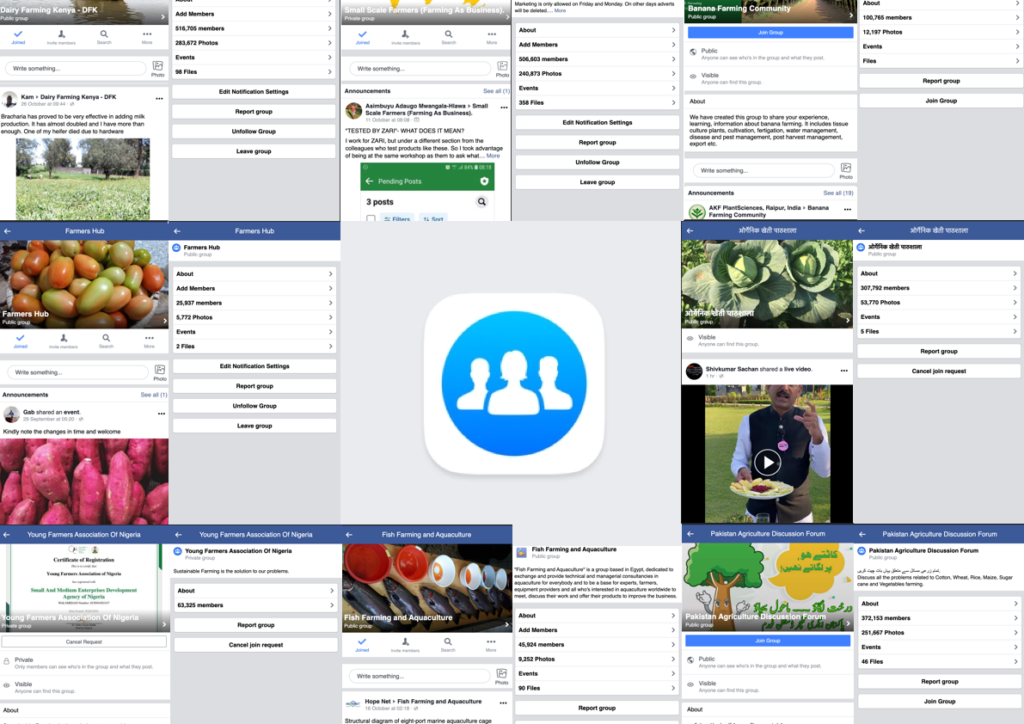
Facebook groups for agriculture are used in almost all of the countries in which examples of social agriculture were found. The image above shows a snapshot of Facebook groups from around the world. This small collection covers countries from Kenya, Zambia, and Nigeria to Egypt, Pakistan, and India. Looking closely at the groups’ “about” pages shows that almost every group boasts tens of thousands of members. Many of the more active groups have collected hundreds of thousands of photos, providing insight into how many posts have been shared on these individual group feeds.
There is no clear estimate of the number and reach of Facebook groups for agriculture. Facebook claims more than 1.8 billion people from tens of millions of active communities use Facebook groups every month globally. However, there is no data on what portion of these are focused on agriculture or from the regions investigated in this research.
A bottom-up approach to understanding agricultural Facebook groups provides some insight. While the global reach of these groups is difficult to determine, in-depth research from Kenya helps build a picture of how social media users interested in agriculture engage with such groups. In particular, we utilize responses from our survey of social media users in agriculture from Kenya and the usage dynamics of a representative Facebook group focused on agriculture in Kenya. This information can help begin to answer bigger questions such as:
- How many agricultural Facebook groups does the average social media–based agricultural worker belong to? How many workers are actively engaged in the group (as opposed to being an “absent member”)?
- If they are engaged, what is the nature of that engagement? Passive viewership? Liberal use of the ‘like’ button? Active commenting and posting?
Social media group membership of agricultural users in Kenya
In our survey, 94% of respondents reported being in one or more Facebook farming groups. Survey participants came from a sample of those who used social media and had an interest or involvement in agriculture. They most frequently reported being members of one to three Facebook groups with a focus on agriculture. Activity rates were self-reported to be little lower than membership, but not by much. Although membership could be an indicator of activity in Facebook groups, users may forget that they are members of some groups (from a platform perspective), so these membership rates are more likely to be an underestimate that overestimate.

Source: learn.ink farmer survey (download chart data)
Similarly, 87% of people reported being in one or more WhatsApp farming groups. While patterns of membership and use were similar, Facebook agricultural group membership appeared to be more common than WhatsApp agricultural group membership. This is interesting, since WhatsApp groups for agriculture are cited more often in the literature, leading to the expectation that this finding would be inverted.

Source: learn.ink farmer survey (download chart data)
These findings are representative of Kenya only, and more research should be done on other countries to understand the nature of these membership and engagement patterns across more countries. Nevertheless, Kenya is an instructive example to examine further, especially its larger active Facebook groups. It seems that membership of these agricultural groups on Facebook is widespread. But how do people actually engage in these groups?
The reach of a large Facebook agricultural group in Kenya
There are four key ways users can engage with a Facebook group. The unique features of a Facebook group (at least in 2021) allow users to post, comment, react, and view content. This order of interactions reflects a decreasing level of effort from the user perspective, i.e., moving from posting to viewing.
📣 Posting — requires the most effort, as a user must start a new discussion and think about how they are going to engage the wider community, often carefully choosing the wording, photos, and timing of their activity.
💬 Commenting — still requires some effort, but involves specifically reacting to a parent post or comment, thus focusing the attention and subgroup with which the user is engaging.


👍🏾 Reacting — requires very minimal effort, entails hitting the “like button,” possibly the smallest piece of effort above and beyond merely looking at the post.
👀 Viewing — the baseline minimum in the attention economy machine, typically characterized by simply scrolling through a feed of posts. Viewing is a necessary condition of reacting and commenting, an almost inevitable condition of posting.

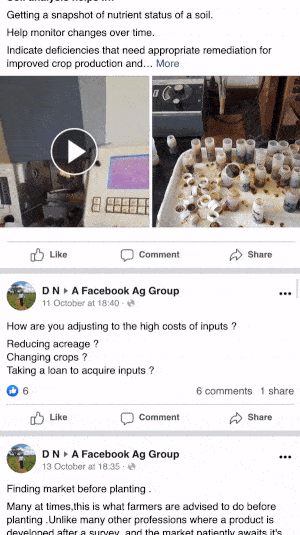
Facebook shares no data on the breakdown of types of usage across their groups, let alone agricultural groups. However, data shared by an admin of a large Facebook farming group in Africa (+100,000 members) provides an example of specific in-group dynamics broadly representative of other similar groups focused on agriculture (e.g., with the same order of magnitudes in terms of membership and level of daily visible engagement).
User engagement increases exponentially when moving to lower-effort interaction categories. Data made available to group admins on Facebook groups is displayed on an internal dashboard within the platform. This enables an analysis of daily post, comment, reaction and viewing data (in aggregate and anonymized), including average daily totals for the aforementioned key engagement types:
- Average daily posts = 8 📣
- Average daily comments = 59 💬
- Average daily reactions = 199 👍🏾
- Average daily views = 11,677 👀
Plotting these on an exponential vertical axis in the chart below shows how each type of engagement exponentially builds on the last. A modest amount of higher-effort input, e.g., posts and comments, can lead to huge numbers of lower-effort engagers, i.e. viewers. The total reach of daily views (in this case) accounted for just under 10% of all group members, giving some indication of daily active use of this Facebook group.

Source: Facebook Group Admin Analytics (download chart data)
Facebook’s business model creates an incentive to generate high engagement. The mechanism driving views likely comes from the algorithms Facebook uses to generate personalized timelines for each user. The way the algorithms operate is essentially a black box. However, the aim of these algorithms seems clear: keep users spending time on Facebook habitually and for as long as possible, then maximize the opportunity to show users ads they are most likely to interact with in ways advertisers will pay for. Facebook groups seem to be an increasingly useful part of this larger mechanism, as they provide large bodies of content from which Facebook can draw material to present to users to keep them on the platform, i.e., as part of individualized timelines.
How does these ideas about the basic features of Facebook groups and the underlying platform mechanisms that generate group engagement related to the concept of social agriculture? Is every interaction inside one of these groups an instance of social agriculture, or only some of them? What types of activity are occurring more frequently, e.g., information sharing or buying and selling? Given the difficulty of getting data from Facebook at present, are these questions even answerable? To help answer these tougher questions, the following section presents the most sophisticated analysis undertaken as part of this research.
A breakdown of social agricultural–related activity within a large-scale Facebook farming group in Kenya
This section analyzes a public Facebook group started in Kenya focused on dairy farming. When a user scrolls through the group’s feed, they see many examples of the practices defined as central to social agriculture in previous sections. The snapshot below offers a sense of this experience.
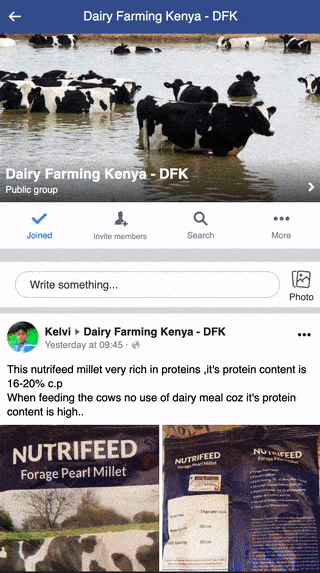
Some specific examples related to social agriculture are highlighted in the images below, illustrating information sharing and marketing in particular. (Note: personally identifying information has been redacted from images.)
Information sharing
- Giving advice. A user shares tips about their experiences of dairy farming, talking about the specific setup used in terms of land use for five dairy milking cows.
- Asking advice. A user shares a picture of cow excrement and asks for advice about what the problem might be.
- Asking advice. A user asks for advice about the milking process and why the fat content has changed.


Marketing
- Selling. A user posts a picture of a cow for sale and quotes the specifications and asking price, along with a contact phone number
- Buying. A user makes a request to find a calf to buy in their area, stating their price range.
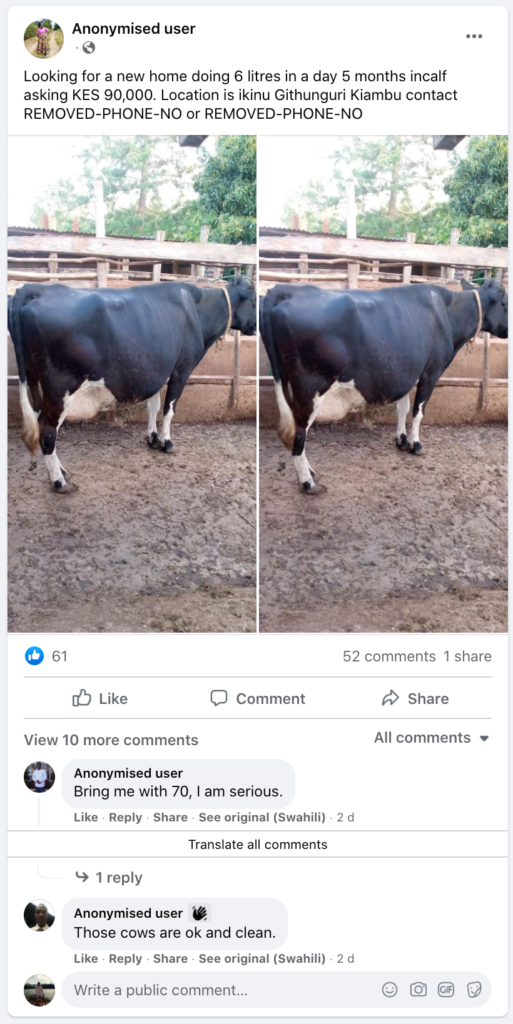

This group also shows an interesting trend of “influencing.” For the purposes of this research, “influencing” is defined as the practice of creating content for the purpose of garnering attention, building a reputation, and growing an audience. The user may be aware that this is what they are doing or, in some cases, the drive to generate attention may be subconscious. A few examples are discussed below.
Influencing
- A user shares an update to showcase that their farming is going well. While the influence-building character of this post is implicit and subtle, the purpose of such posts tends to be generating reactions that help boost a user’s reputation and standing in the group.
- A user shares a link to a WhatsApp group asking members to join a subgroup focused on the topic of poultry farming. They offer to send a free online farming guide as an incentive to join.


Building on our understanding of what kind of content is being shared in a Facebook group focused on agriculture (and noting that the structure of other groups appears very similar), we undertook a unique analysis of over 10,000 posts from the Facebook group shown above. Results are showcased in the next section.
Analyzing the content of 10,000+ posts from a dairy farming group in Kenya

The post data from the dairy farming group over a fixed period was anonymized. A labelling protocol based on the different types of posts outlined above was developed. A crowdsourced team of labelers, who passed a mini-entrance test to establish their accuracy in following the labelling protocol, was enlisted to produce a labelled sample of 10,000 posts.
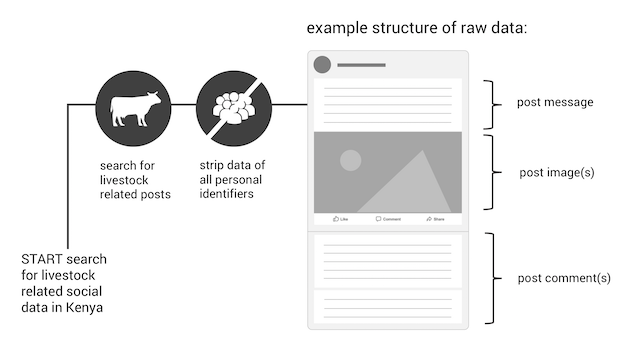
The labelled dataset gives a clear indication of the structure of the Facebook group in relation to some of the social agriculture–based activities investigated in this research. Four main labels were used for each post:
- Marketing: The post was essentially about buying or selling items related to the agricultural topic, in this case dairy farming and livestock.
- Information sharing: The post was about requesting or sharing information related to the agricultural topic.
- Influencing: The post was about generating a reputation or building an audience, where this was clearly related to the agricultural topic.
- Other: The post was off-topic, meaning it is typically spam.
Of course, there are grey areas in this labeling process; some posts are difficult to categorize as they seem to work in multiple ways. The labeling procedure was carefully iterated to find a process that generated good results from test samples of labelers (which were manually reviewed), where category labels were within acceptable margins. The labeling process also sourced results from multiple reviewers to provide confidence scores, on average three labels per post. The technique used a human-in-the-loop labeling platform specifically designed to support building training datasets for training machine learning algorithms.
A breakdown of the 10,000 posts is shown below.

Source: Facebook group data, learn.ink analysis (download chart data)
Marketing posts were the most common type. Marketing posts accounted for a little over a third of the sample, with information sharing and influencing posts accounting for 20% and 12%, respectively.
The group had more relevant content than it did spam by a ratio of 2:1. Together, these categories were deemed relevant to the group’s agricultural topic, i.e., dairy farming and livestock. It’s important to note that Facebook does provide group admins with moderation tools. Typically, a group will have a small team of moderators tasked with removing spam or offensive content. However, these moderators are typically volunteers doing it in their spare time and so many spam posts will slip through. This issue is considered further in the discussion of Some algorithms that underpin social agriculture.
The chart below depicts the daily discuss patterns of the group, including the split of different post types on each day over a year.

The group’s dynamics looked fairly stable and regular over the time frame analyzed. The daily discussion patterns did not notably change in a predictable way over the time frame. While the discussion patterns on different days fluctuated, the groups post mix shows a relatively durable identity over time.
Labelers provided topic-specific subtags based on the main topic label they applied. In particular, when applying a “marketing” label, labelers determined whether the post was about buying or selling. If the “information sharing” label was applied, subtags included giving advice and asking a question. The insights from these subtopic labels are shown below.

Source: Facebook group data, learn.ink analysis (download chart data)
Selling was the most common type of marketing. Posts were more likely to be offering livestock or relevant items for sale (77%) than they were to be about buying (23%). This makes sense for large-scale groups, in which sellers perceive they have a large audience of relevant customers.

Source: Facebook group data, learn.ink analysis (download chart data)
“Providing answers that are of high quality is one of the most important activities for growing groups and generating their appeal in the early days…” —Facebook Agricultural Group Admin (Kenya)
Posts requesting information were far more common than those providing advice. Posts were more likely to be asking for advice (85%) than they were to be providing it (15%). Anecdotally, a few group admins said that “providing answers that are of high quality is one of the most important activities for growing groups and generating their appeal in the early days” of a group’s establishment. At a certain critical mass, users start freely sharing information with each other more. However, establishing norms of goodwill and generosity in freely sharing advice is critical for a group’s success—and can be hard to achieve. If this social group dynamic of reciprocal information sharing is lost, some admins felt the soul of the group would die with it.
Further insights specific to the topic of dairy farming can be found here for those who want to dig further into the data. However, the key takeaway from this analysis is that a large-scale Facebook group focused on agriculture can contain instances of the practices defined here as characteristic of social agriculture. Interestingly, in the example group, practices of information sharing and marketing consistently dominated the discussion. By and large, it appears that features available to users in these groups can be used very successfully for the purposes of social agriculture. Learnings from this particular group may well be useful to others building group structures for social agriculture.
The gender dynamics of group engagement
In an earlier analysis from 2018, the Farm.ink team examined the dynamics of group engagement between men and women. Some of the granular findings are shared below and provide interesting context to some of the findings in this report.
- Female content creators created 30% fewer posts than men did, but made 20% more comments.

Source: FB data, farm.ink analysis
- Comments from women are rated more highly, though not by much.

Source: FB data, farm.ink analysis
- Women are almost twice as likely to comment with a very positive sentiment. This analysis suggests that comments by women are more likely to fall into the “words of encouragement” category than comments by men.

Source: FB data, farm.ink analysis
More findings concerning gender dynamics in social agriculture are explored in a later section on the experience of social agriculture from users in Kenya.
The next section explores some algorithms that underpin social agriculture to better understand how particular social media platform structures might have adverse effects upon social agriculture more broadly.
Social agriculture depends upon the logic of social media platforms, which largely depend on ad-driven business models. The full extent of algorithms and features that power these social media platforms exceed the scope of this report, but a few examples have clear bearing on social agriculture.
Temporal messaging queues reflect an intuitive model of everyday communication
“Temporal messaging queues” are the most basic example of an influential algorithm. This feature underpins some of the major platforms used for social agriculture, such as WhatsApp and Telegram.
The technical details of how these queues are implemented are not relevant to understanding their impact. The most important aspect of these queues is that messages are brought to a viewer’s attention based on the time they were sent.



People often seek this predictable design in social agriculture. The temporal messaging queue reflects an intuitive model of everyday communication, i.e., the message at the top of the stack of messages which grabs a user’s attention is simply the last thing sent. These models are intuitive, predictable, and easy for users to understand as everyday communication utilities. Tools that use this messaging paradigm have become critical for everyday agricultural practices, like sending instructions to a farm manager or taking orders from customers. This model serves as an important contrast to the very different model of “algorithmic news feeds.”
Algorithmic news feeds fundamentally distort information-sharing practices in favor of attention
Most social media platforms employ some form of news feed feature. This acts as a personalized front page for every user, where information presented at the top of the feed to each person is carefully orchestrated by algorithms. Platforms like Facebook and Douyin use this model.


News feeds are critical to these platforms’ advertising business models. The way these feeds work is opaque, as compared to the simple messaging queue model outlined above. These systems required complex software architectures from their earliest incarnations. (Facebook first released the news feed in 2006). The video below explains how Facebook’s current news feed is powered by machine learning to score posts based on “signals” (such as user likes). The video claims this work enables Facebook to personalize the news feed for every user with “the content that matters most to them.”

Source: Facebook
There are reasons to doubt that Facebook’s algorithm straightforwardly personalizes our news feed to show us posts that matter most to us. The company’s business objective is better described as maximizing “time on device,” a term taken from the gambling industry to measure the performance of slot machines. In fact, news feed algorithm design has been inspired by concepts from slot machine design, such as irregular or intermittent reward schedules to keep users hooked. These algorithms maximize attention, not content value, from a user perspective.
Intermittent reward mechanisms generate more “time spent playing”, play with a great interactive demo to learn more

Time on device is misaligned with the requirements of better information exchange. If such news feed algorithms are designed to maximize time on device, this is problematic for social agriculture. As discussed in Examining large-scale groups in social agriculture in Kenya, information sharing in large agricultural groups accounted for a significant share of posts. Moreover, when asked about The experience of social agriculture from users in Kenya, agricultural workers reported that “getting farming tips” was their main activity, suggesting that information exchange observed in groups was “what matters most” to users.
Agriculture is complex, and farmers require reliable and accurate advice. However, as one Kenyan agronomist put it, “there is a lot of wrong information on Facebook.” This perspective is shared by an academic who found issues with the quality and accuracy of information being shared on Facebook agricultural groups in Sub-Saharan Africa. To what extent are Facebook’s algorithms at fault for this? Unfortunately, the needs of a farmer to get the correct answer to her agronomic question are fundamentally misaligned with a system designed to maximize her time on device. Even if platforms like Facebook have the means to provide better answers to farmers’ agronomic questions, they (and their algorithms) may lack the incentive to do so. Indeed, some have noted how novelty may drive the spread of falsity on social media platforms. This same novelty may drive lower quality agricultural information exchange. Contentious and inaccurate information might better stoke the emotions of farming audiences and generate views than factually correct answers would. This might be good for social media’s attention economy, but it is bad for farmers’ information ecosystem.
Indeed, when asked to share their opinions about Facebook, survey participants from Kenya described the tension between a vapid attention economy and useful information exchange for agriculture:
“Facebook being without many restrictions and global is prone to fraud information for the sake of making sales.”—Joni, student from Nakuru
“A closed community is needed for a farming group whose main agenda is people sharing honestly and exchanging useful information. Most groups end up being one sided where the main objective becomes selling farming inputs.”—Catherine, farmer from Nairobi
Facebook’s news feed algorithm might be a great asset to an ad-driven business model, but may also be an impediment to serving the information exchange needs within social agriculture.
E-commerce algorithms may distort—or even control—the prices of agricultural commodities
In China, some of the biggest players in social agriculture are e-commerce platforms that fall into the “social and group shopping” category. These platforms create algorithms to power personalized recommendation engines. Examples include Pinduoduo and Taobao.
The video below illustrates Pinduoduo’s user interface. The narrator makes the interesting point that:
“People usually go to Pinduoduo without a clear idea of what they want to buy and just browse for fun … Pinduoduo is a browsing-centric product not a search-centric product.”


A video explainer of the Pinduoduo app interface.
While these personalized recommendation engines might seem innocuous, some claim that traditional informal sales networks are deteriorating as rural agricultural communities move to e-commerce in China. They see these informal networks as offering a balanced distribution of power between actors, including multiple middlemen working in these systems.
“E-commerce, on the other hand, is strictly institutionalized, and algorithms promote a few crops with outstanding sales or profit margins over all others. Further, the platforms are natural monopolies, and rural communities have no power to bargain with them in comparison as they would with brokers in an informal network.”—Researcher Liu Weiqi
Moreover, e-commerce recommendation engines have the power to disrupt agricultural prices. When commenting on the success of their group-buying model (outlined in the image below), a Pinduoduo spokesperson said:
“It helped us aggregate a large number of orders in a short period of time, so we could become a meaningful buyer of fresh produce. At one point we were influencing the market prices of fresh produce because we were such large buyers.”

Source: Pinduoduo investor deck.
The situation becomes even more complex when Pinduoduo links the app’s in-game features to real fruit purchasing programs. They claim that “60 million daily active users receive 1 million kilograms of fruit everyday.” The situation for farmers on the ground can look different, and some say that they’re buying ads on the Pinduoduo platform to promote their produce. This isn’t always successful, as one report highlights:
“Yang Lin sold 30 tons of apples per month on the platform in 2019, but says he ‘made no money’ on Pinduoduo, especially after factoring in the ads he bought on the site to attract consumers. He thinks he could have made a profit on Pinduoduo if he sold more apples, but he quit because that tipping point seemed too elusive.”
If algorithms can rapidly dictate prices, and platforms can quickly disrupt existing market power dynamics, then new market dynamics in social agriculture are far from straightforward. These shifts must be assessed to determine how they are affecting the ecosystem of connected agricultural livelihoods.
Group moderation features place significant power in administrators‘ hands
The proliferation of spam, misinformation, and abuse on social media means that content moderation is often an essential part of running a digital group. Social media platforms typically provide features for the “admins” and “moderators” of groups to control the content and membership of those groups.
Facebook recently announced a swathe of New Tools to Help Community Builders Manage and Nurture Their Groups. A few example of features offered to admins are given below.
- Admins can “restrict people who don’t qualify to participate based on several options, such as how long they’ve had a Facebook account or how long they have been a member of the group.”
- Admins can “reduce promotional content by declining posts and comments with specific links.”
- “In situations where it may be helpful to slow down a conversation, admins can temporarily limit how often specific group members can comment, and control how often comments can be made on certain posts that admins select.”
A helpful instructor from Nigeria provides an overview of some of the functionalities of these tools in the video to the right. He showcases how admins can automatically decline posts based on preset criteria such as keywords.
These admin features are powerful. They often give a single individual unilateral control over membership and speech within a group. Unfortunately, there are many reports where this power is abused, especially where admins have vested interests to promote or conceal certain information, or even bar competition from engaging with the community. Communities themselves have no democratic power, and so live inside mini-dictatorships architected by the Facebook group feature design. While Facebook may have invested heavily in researching and designing these features for group admins, they are required to take a “one size fits all” approach. Facebook has no other option here if groups are to be offered as a global feature serving every possible use case. However, this can seriously limit the viability and efficacy of their features.
Social agriculture has distinctive requirements, and The experience of social agriculture from users in Kenya helps refine those needs further. It’s not clear that Facebook’s unilateral admin features help promote the support structures that are valuable in social agriculture, and it will be interesting to hear more from individual farmers and others about their experiences on the “sharp end” of these features.
What are the right algorithms and features for social agriculture?
This section highlighted a small sample of relevant platform features, explaining how they impact social agriculture. In general, the features examined here are contentious and potentially orthogonal to the spirit of social agriculture. This report purposefully avoids proposing the “right” algorithms and feature sets for social agriculture. This issue will require much more research. If nothing else, however, ideally some of the insights in this (and other) sections spur others to engage this “million-dollar question” head on.
The next section illuminates 🤳🏾The experience of social agriculture from users in Kenya generated from a set of more than 300 survey participants. As established throughout this report, in a country like Kenya, social agriculture is big, and a significant amount of it is happening in Facebook groups, but what exactly do users think of it?
Surveying social media users interested in agriculture in Kenya
Justification for a focus on Kenya was explained in the section🧩Examining large-scale groups in social agriculture in Kenya. This section expands upon these findings with results from a survey of more than 300 participants taken from a wide sample of Kenyans working in agriculture using social media. Participants included a mix of genders, age groups, and occupations including farmers, agronomists and agricultural students. Using the survey we aimed to tackle some of the questions below:
- How critical is Facebook to everyday agricultural livelihoods in Kenya? The survey found that Facebook was the most important platform for social agriculture in Kenya. However, audiences in North America and Europe increasingly want to leave or reduce dependence on Facebook. Is this finding mirrored in the survey results from Kenya?
- How do people value different practices in social agriculture? As discussed in the previous section Examining large-scale groups in social agriculture in Kenya, marketing is a dominant activity on large-scale Facebook groups (at least by post volume). Information sharing is prominent (particularly information requests). What do users prioritize in their own minds when it comes to marketing versus information sharing?
- What are users’ perceptions of trust and safety? Facebook has suffered a crisis of trust globally. Is this finding reflected in the experience of people using it in relation to their everyday agricultural work in Kenya?
- How do different groups experience social agriculture in Kenya? Is the experience of social agriculture different for men than for women? Are there differences based on age, or type of occupation in agriculture (e.g., farmer vs. agronomist)?
Notes on survey method
Creation. Participants received a digital survey built on the microlearning platform Learn.ink. The survey’s appearance to participants appears in the example on the right. An engaging conversational user experience was mixed with images and videos to help achieve impressive completion rates. More than 300 survey completion were quickly and efficiently generated.
Sharing. A Facebook advertising campaign targeted users over 18 years of age living in Kenya with an interest in agriculture (i.e., the FBinAg audience specification used in earlier analysis). The other half of the total number of participants was obtained by asking a small group of Kenyan farmers and agronomists working on social media to share the survey with their own networks of agricultural contacts, targeting those that used social media for agricultural purposes.
Gender parity. The survey sample achieved close to a 50:50 split of male to female users. (Data showed that surveys delivered via social media campaigns in Kenya to the target audience naturally skewed 70:30 toward men without intervention). Two tools were employed to counteract this skew: (1) campaigns that exclusively targeted women on Facebook and (2) specific requests to individuals to source a 50:50 mix of men and women.


Source: Learn.ink farmer survey (download chart data)
Sample occupational mix. Participants included wide variety of individuals working in agriculture. This was reflected when users described their role in agriculture (as seen in the chart below). The three major occupations of users were:
- Farmers (44%)
- Agronomists (24%)
- Students (14%)

Source: Learn.ink farmer survey (download chart data)
How critical is Facebook to everyday agricultural livelihoods in Kenya?
Overall, users reported that social media has been good for farming. Three-quarters of participants said that a time before social media and farming was worse than their current situation; only 7% thought farming was better without social media. This finding was consistent across gender, age, and occupation. In addition, when asked about the general experience of social media, people rated it over 4 out of 5 on average across every group.
This point should be reemphasized for a balanced analysis in what follows:
Social media is perceived as a net positive for farming in Kenya by those working in agriculture. This doesn’t mean social media is working perfectly (as shown below), but there are lessons that should be taken from what is working well (as well as not so well) for agriculture.

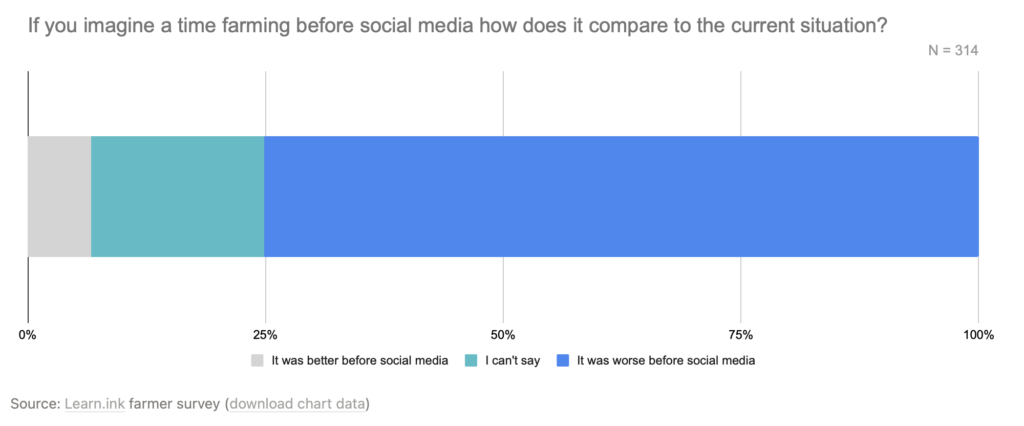
Source: Learn.ink farmer survey (download chart data)
Facebook dominates usage in farming. Over 60% of people said they Facebook was their favored platform for social media when it came to farming, as well as believing it was the most important. This finding was consistent across gender, age, and occupation. Overall, Facebook’s dominance was surprisingly high given the many examples from the literature review citing other platforms, notably WhatsApp.


Source: Learn.ink farmer survey (download chart data)
People aren’t likely to leave social media any time soon. A staggering 95% of people said they will “always remain” on social media, as opposed to “wanting to leave soon” or even “leaving eventually.” This was consistent across genders, age, and occupation. These findings contrast with findings from North America and Europe that suggest people are increasingly weary of Facebook and seeking ways to reduce their usage of the platform or stop entirely.
This raises a question for those involved in agriculture in Kenya: what are the reasons for staying on a social media platform like Facebook?

The availability of useful agricultural information, markets, and networks at scale drives value. After participants reported their favored platform, the survey asked them to explain their choice. When choosing Facebook, people often mentioned the value of information sharing and marketplace interactions, typically conducted in groups. People also regularly mentioned that Facebook simply reached more people in rural communities, enabling the platform to get the attention of farmers. These findings are consistent with the analysis Examining large-scale groups in social agriculture in Kenya, which found that marketing and information sharing dominated a large group’s discussion. Some examples of participants’ reasons for choosing Facebook are cited below.
Why select Facebook as the most important platform for farming?
“Because that’s where most people are and there is a lot of agricultural information.”—Julius, farmer from Bomet
“Because of the market place and the ability to have a Facebook group or page to sell or even learn from agronomists and other farmers.”—Carol, farmer from Makueni
“Has a network of many different groups of people i.e there are buyers, sellers and farmers … so I get a lot of information from the farming groups.”—Charity, farmer from Elgeyo-Marakwet
“It is easy to advertise your products for Facebook is used by many people.”—Paul, farmer from Elgeyo-Marakwet
“Because there can be live interaction of experts with farmers on matters education into better farming practices… I have witnessed such occasions and they are very empowering.”—Steven, farm manager from Laikipia
‘90% of Kenyans has Facebook accounts so it’s easy to connect and communicate.”—Bernice, farmer from Nakuru
“It can be accessed by even the common farmers and can accommodate a larger number of people.”—George, student from Kericho
“Most people in rural areas are fond of Facebook mostly. Hence it’s easy to get attention of the farmers … they can view it even after a long period of time unlike WhatsApp where status expires after 24hours. Though [WhatsApp] is also important … Facebook reaches out to many people.”—Gerald, farmer from Bungoma
“Because that’s where you interact with most farmers all over the world.”—Gladys, farmer from Kiambu
“Because a big number of people can see your post even those whom aren’t your friends.”—Joy, student from Embu
The dependence of agriculture on social media in Kenya
Social media is a tool people depend on in within agriculture. Almost three in four people said they “must be on” social media in relation to their farming activity, as opposed to feeling that they were on it because they wanted to be. This surprising finding shows that there may be hidden “lock-in” effects that powerfully affect agricultural workers in Kenya when using social media platforms like Facebook. Findings were consistent across genders, age, and occupation.
Source: Learn.ink farmer survey (download chart data)

Dependencies were often income based, but also more wide reaching. The survey revealed that three in four people engaged in social media in the evenings for the purposes of agriculture. Coincidentally, the survey was released shortly after Facebook’s major outage on October 4, 2021. This outage left farmers and others unable to access the platform for many hours in the evening; the survey also asked participants about this experience.
A majority—84%—of survey participants noticed the outage. One in two people said the outage affected them negatively in relation to their work in agriculture.
Common reports included:
- A loss of income and business related to agriculture.
- Missed learning opportunities related to agriculture.
- A general disruption of operations related to agriculture.
“I was to make an order of farms inputs through WhatsApp, but that didn’t happen.”—Fredrick, farm manager from Narok
“I always do farm input marketing via WhatsApp and Facebook, as a result of the outage, I experienced a small reduction on my agricultural produce business.”—Boniface, student from Elgeyo-Marakwet
“I take my vegetable orders via WhatsApp, when it failed , I had to call them personally.”—Joni, student from Nakuru
“I was to sell my Broiler’s chicken on the following day and the client wanted samples of which I never sent due to WhatsApp and Facebook shutdown.”—Thomas, agronomist from Elgeyo-Marakwet
“I couldn’t interact with other farmers who have become family.”—Esther, farmer from Meru
“I was not able to get ideas I had saved there.”—Paul, farmer from Elgeyo-Nakuru
“My day to day reliance on both platforms is a reality, that day I missed a lot including the knowledge I usually obtain from a page on Facebook.”—Felix, farmer from Elgeyo-Marakwet
“I was to send a video of myself preparing the farm ready to plant vegetables to a new interested acquaintance.”—Fred, farmer from Murang’a
“As a student most of ours communications are made via the social media accounts especially WhatsApp. Reception of documents was delayed as a result of the outage. All meetings on the platform had to be postponed.”—Winny, student from Homa Bay
Most people report that income in agriculture depends upon social media. A significant 57% of participants said that if social media was to be shut down it would negatively affect their income from agriculture.
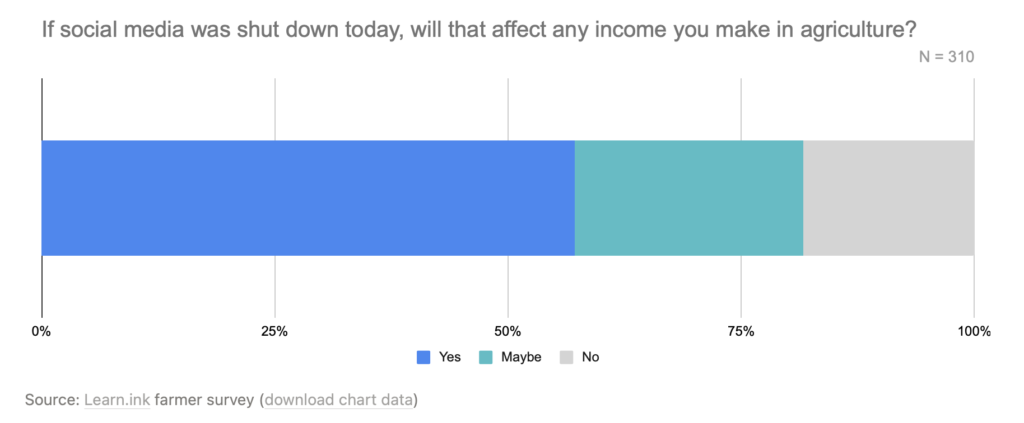
Source: Learn.ink farmer survey (download chart data)
This finding of income dependence did not vary significantly across gender or age, but did across occupation. Three of four agronomists said a shutdown would affect income, while only roughly one in two farmers and students said this would happen. This makes sense, since agronomists typically depend on reaching many farmers to generate income, so would conceivably use social networks more heavily than either students or farmers. Nevertheless, social media dependence was significant across all occupational categories.
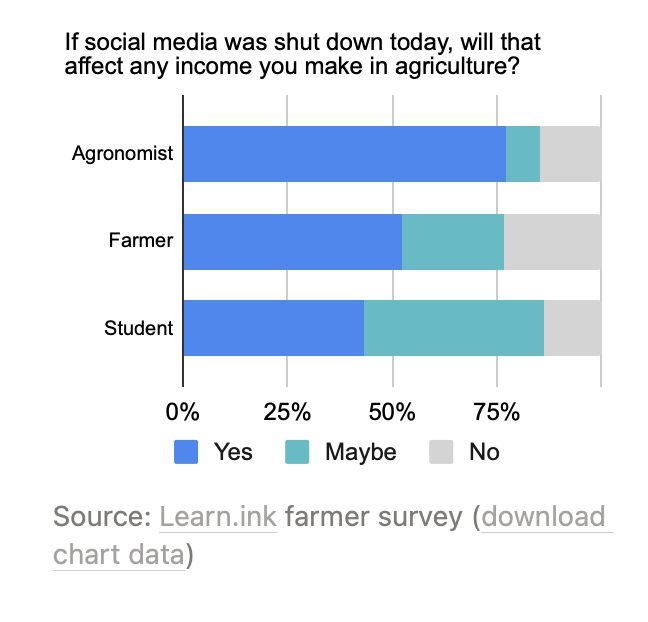
Source: Learn.ink farmer survey (download chart data)
Social media platforms (e.g., Facebook) don’t formally sync up with payment infrastructure (e.g., MPESA) in Kenya, so why do so many report an income-related dependence on social media? The simple answer might be marketplaces. As discussed throughout this report, Facebook groups are being used as marketing channels for selling agricultural goods and services. While payments likely depend on MPESA or cash, the large marketplaces are on Facebook, and lack of access to these channels may well adversely affect income.
“Social media has helped me connect to more farmers and move my financial capacity significantly so it is an important tool to have.”—Anna, farmer from Kiambu
It’s not clear how social media is affecting income for those working in agriculture. Participants generally see social media as a positive development for agriculture, thus a positive effect on financial outcomes could be assumed. However, one in three people said they experienced financial losses in agriculture in relation to social media. This finding was generally consistent across all groups, and it’s not clear whether this represents business as usual in agriculture or losses that could have been avoided. Exactly how these economic losses are linked to social media is a question for further qualitative research.
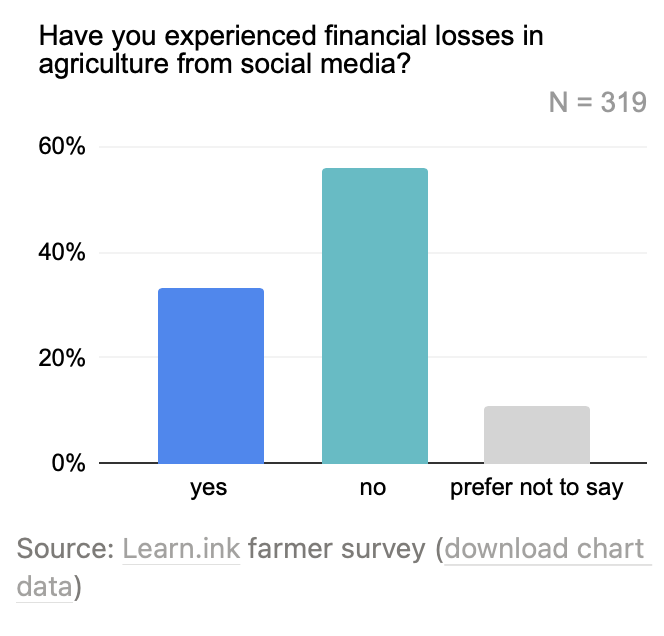
Source: Learn.ink farmer survey (download chart data)
Some participants shared concerning stories about financial losses, often centered around conmen and the challenge of knowing who to trust on social media.
“If you met on Facebook you can look how active that account looks but if you suspect its a pseudo just run otherwise u might loose everything.”—Erick, farmer from Kiambu
“I almost delivered 2tonnes of Onions to a conman in Nairobi I am glad I sensed the danger before delivering This could have brought my farming business on its knees.”—Eunice, farmer from Meru
Issues of trust are explored further in a section below. Before turning to these issues of trust, however, a closer look at the activities participants said they engaged in on social media related to agriculture is necessary.
The main activities of agricultural users on social media in Kenya
Information sharing and influencing (not marketing) are the dominant activities.
Information sharing and influencing are the main activities in agriculture on social media. Seventy-three percent of users said requesting information (e.g., in the form of tips) was their main activity on social media when it came to agriculture. Twenty percent said influencing others was their main activity. Only 6% said buying and selling was their main activity.

Source: Learn.ink farmer survey (download chart data)
This finding was consistent across gender and age. However, there were differences across occupation; agronomists were more likely to be influencing rather than requesting tips. This makes sense given agronomists are generally advisors to farmers.
Information sharing dominates mind-share but not post-share. Survey results suggest that information sharing and influencing are the dominant activities. This contrasts with the finding that most post content (by volume) in large agricultural groups concerns buying and selling. Why might this be?

Source: Learn.ink farmer survey (download chart data)

Source: Facebook group data, Learn.ink analysis (download chart data)
One explanation comes from the fact that most of the activity people engage in is “viewing” rather than “posting” in these groups. In fact, examining engagement data in one such group showed that one post generated approximately 1,000 views. The high proportion of people who claimed that their main activity is “getting farming tips” reveals the unequal value of posts by type in these groups. Information-sharing posts, while accounting for roughly 20% of volume, will likely account for most of the value as perceived by group users. There appears to be an important connection between information sharing and marketing—the value created by the former may well create the foundation for a group which facilitates the latter.
Agricultural buying and selling on social media in Kenya
Surprisingly, information is the top item people buy on social media. The surprising role of “information” goes even deeper—one in two people reported that information was the top thing they bought on social media related to agriculture. Although the dominance of buying agricultural inputs was expected, it was mentioned less often than information purchasing. Interestingly, this finding contradicts some of the literature on digital agriculture which finds that “individual farmers usually are not in a position or willing to pay for digital agro information services.” The findings of the survey suggest there may be a missed opportunity to better understand the nature and value of information gaps for those working in agriculture in Kenya.

Source: Learn.ink farmer survey (download chart data)

Source: Learn.ink farmer survey (download chart data)
Produce is in the top selling spot, but information and services are high. One in three people said produce is the top thing they sell on social media, but one in four said the top item they sold was advice. This suggests that there may be a fairly large fragmented market of information and service providers. Presumably, this market is largely serving farmers, but little is known about the composition and nature of this set of services. Social media appears to be a fertile basis for this industry, and it would be interesting to understand how many of these services existed before social media and adapted to life on the platform versus how many originated as opportunities on the basis of affordances of social media platforms alone. Further research on the efficacy of these services and the experiences of people who purchase them is also vital.

Source: Learn.ink farmer survey (download chart data)
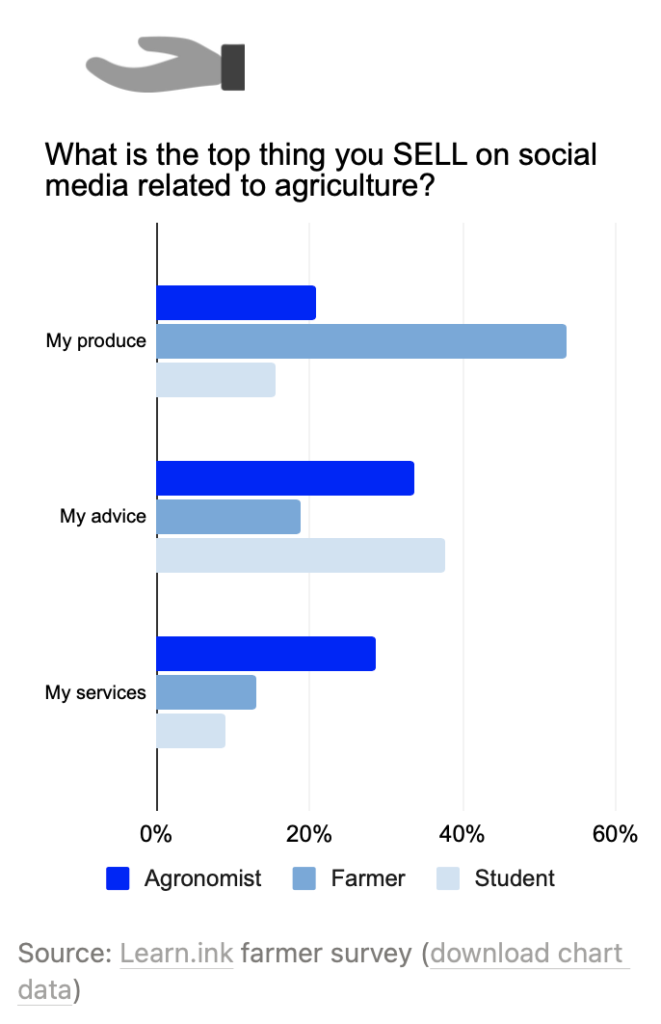
Source: Learn.ink farmer survey (download chart data)
Occupation creates the biggest differences in buying and selling trends. The top buying and selling trends remained largely unchanged across gender and age. However, varying occupation yielded different trends. Agronomists were far more likely to sell advice and services, while farmers were more likely to sell produce. Interestingly, three in four agronomists said the top thing they bought was information, but this might make sense since the top thing they sell is advice. Exactly how agronomists are adding value to such information would be an interesting area of further investigation.
Trust and safety on social media in Kenya for those working in agriculture
People working in agriculture rate Facebook as “least trustworthy”
Facebook was voted less trustworthy than Kenyan Mobile Operator (Safaricom) or the Kenyan Department of Agriculture. When asked about what large organizations affect their work in agriculture, participants often talked about Facebook, Safaricom (Kenya’s biggest mobile network operator), and the Kenyan Department of Agriculture. The survey asked which of these organizations participants trusted the most and trusted the least.
- 42% trusted Safaricom the most, 40% trusted the Department of Agriculture the most, and 18% trusted Facebook the most.
- Conversely, 40% trusted Facebook the least, while 34% trusted the Department of Agriculture the least and 26% trusted Safaricom the least.
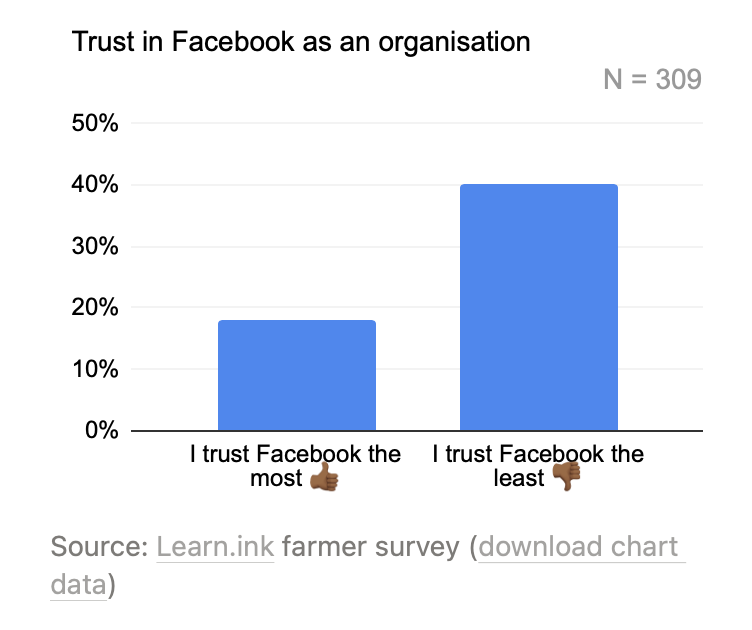
Source: Learn.ink farmer survey (download chart data)
Lower trust in Facebook is potentially surprising given that the majority of participants said that farming in a time before social media was worse — so why did Facebook get a relatively poor trust rating?
Scamming and disinformation were frequently cited as reasons for lower trust in Facebook. Participants were asked to explain their reasons for saying Facebook was the least trustworthy organization. A selection of responses are shown below.
“Facebook being without many restrictions and global is prone to fraud information for the sake of making sales, hence the least trusted.”—Joni, student from Nakuru
“Facebook bloggers are just interested with seeking fame.”—Gabriel, student from Laikipia
“They can easily accommodate scammers.”—Wilson, farmer from Murang’a
“There is a lot of wrong information on Facebook.”—Alex, agronomist from Kirinyaga
“Facebook may share private data with other global data companies but Safaricom is trusted in Kenya.”—Isaac, student from Kiambu
“Safaricom can reverse your money if someone tries to con you, but on Facebook people can give misleading information.”—Jackson, farmer from Kiambu
“Safaricom prints its statement regularly while in Facebook there are many liars.”—Mishek, student from Kiambu
“Am so passionate about agriculture and so I trust the department [of agriculture] so much … Facebook I least trust it because we have culprit of lies.”—Nancy, agronomist from Nyandarua
“Kenya department of agriculture is approved and you can trust it where else Facebook you can be conned you can’t trust it 100%.”—Symon, Farm Manager from Murang’a
There is “50/50 trust” in information and people on Facebook. When it comes to agricultural discussion on Facebook, one participant put it as follows:
“Facebook is not necessarily verified … most of the information provided by the users are opinions which is 50/50.”—Joe, farmer from Kiambu
This view is largely reflected across all participants, who assessed that the information and people on Facebook are trustworthy just over 50% of the time. While 50/50 trust in a system doesn’t sound terrible, when combined with earlier findings of a strong dependence of agricultural workers on social media (including for part of their income), this level of trust highlights concerns with the suitability of social media platforms to support agricultural livelihoods in Kenya (and elsewhere).
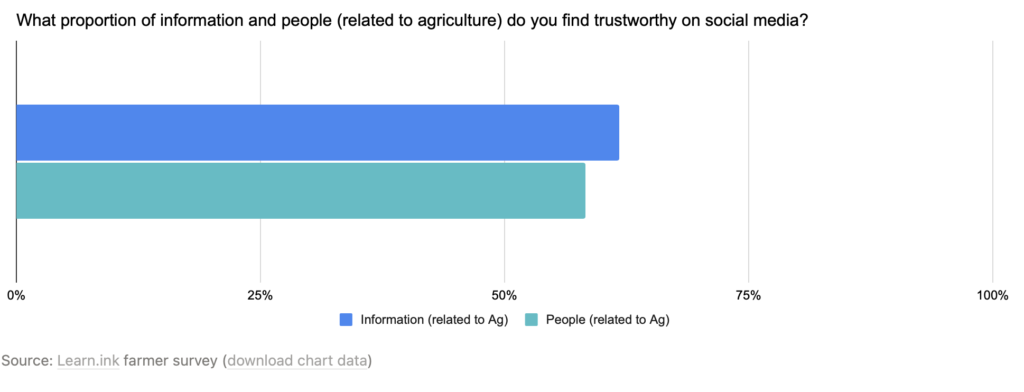
Source: Learn.ink farmer survey (download chart data)
Widespread bullying and abuse online is concerning
Three in four people reported that they have seen bullying or abusive behavior on social media in relation to agriculture. Investigating further will be important, but must be handled delicately as many participants are likely reticent to share the details of their experiences for fear of repercussions.

Source: Learn.ink farmer survey (download chart data)
Women are perceived to be the targets of abuse on social media relating to agriculture. Most participants believed that women and younger people suffered the most from bullying or abuse on social media. Some of the reasons given for this were concerning.

Source: Learn.ink farmer survey (download chart data)
“Society tend to undermine woman’s professional knowledge in agriculture.”—Daisy, Agronomist from Embu
“Because some men on social media will use bullying abusive language related to body shaming when they don’t agree with a woman’s point of view” — Lydia, Student from Kiambu
Personal reports of abuse show parity between men and women. When participants were asked whether they had personally experienced bullying or abuse, the results were different across gender. One in four participants reported being a victim, but this was consistent across gender and age. Nothing further was asked about the nature or severity of experiences of bullying or abuse, and the fact that people thought women and younger people were more adversely affected warrants further investigation here. Either way, it’s deeply concerning that personal experiences of bullying or abuse occurred so frequently across participants.

Source: Learn.ink farmer survey (download chart data)
Three in four participants said they had reported abusive posts or people to Facebook. Presumably, many of these reports involve documenting disinformation, conning practices, or abuse/bullying. This level of reporting is high and demonstrates that most participants are trying to bring concerning practices to Facebook’s attention.
Illuminating perspectives from participants
At the end of the survey, participants were asked if they had any final thoughts to add about social media and its use in agriculture in Kenya. Here are some of their insights explaining what’s going well in social agriculture and what needs improvement.
👍🏾 What’s going well when it comes to social agriculture?
“Agriculture is a great adventure and through social media i have learnt of new crops, products, farming technologies.”—Cynthia, student from Meru
“I’ve met some friends online that motivated and pushed me to own my land, that am currently developing and working to becoming self sufficient by growing own food and raising own animals.”—Kipkorir, farmer from Kwale
“Through social media I have visited several farmers for benchmarking services and this has really helped me in gaining major skills.”—Margaret, farmer from Kiambu
“I’ve been able to make numerous connection on social media which have proved to be beneficial down the line.”—Brian, agronomist from Kirinyaga
✋🏾 What should be improved when it comes to social agriculture?
“If we could positively use the social media platforms, we stand to gain from all angles. We can access information which will help improve farming practices thus greater produce. It creates a platform to purchase and sell all farming related materials from inputs to produce.”—Dennis, farmer from Kirinyaga
“Let social media be platforms where we share useful information rather than abuse.”—Bramwel, farmer from Kisii
“A closed community is needed for a farming group whose main agenda is people sharing honestly and exchanging useful information. Most groups end up being one sided where the main objective becomes selling farming inputs.”—Catherine, farmer from Nairobi
“The general population is quite skeptical about conducting transactions based on social media. This has to be corrected for agriculture to greatly benefit from social media inventions.”—Arnold, agronomist from Kiambu
The size of social agriculture versus digital agriculture in Sub-Saharan Africa
An earlier section,What is “social agriculture” and why should we care?, highlighted a distinction between “social agriculture” and “digital agriculture.” The latter was understood as “digital platforms created by foreign and local tech firms … promoted as generating opportunities for farmers, shaping a vision of digitised agriculture.” The previous section argued that these two were different. Therefor, this section asks: which category—social agriculture or digital agriculture—is actually reaching more people?
The size of digital agriculture in Sub-Saharan Africa
A recent report on the Digitalisation of African Agriculture provides an extensive overview of digital agriculture (D4Ag) services and draws on a database “that tracks 390 active D4Ag solutions in Sub-Saharan Africa.” A list of the top 20 solutions (by registered users) in the report is provided below.
The following key findings help build an estimate of the number of active digital agriculture users.
- Across 390 active services analyzed, there are a combined 33.1 million registered users of digital agriculture (D4Ag) services across Sub-Saharan Africa.
- The 20 solutions listed above (~5% of the total) account for over 80% of all registrations, leading to the conclusion that the long tail of services will not significantly affect sizing estimates.
- The percentage of accounts used “regularly enough for the users to feel the full benefit of the solution” is 15–30% of the registered user base. This is rather vaguely formulated, but reads like an active user estimate (similar to the “Monthly Active User” metric used by social media platforms).
While the report highlights the number of “registered D4Ag users” (33.1 million), this figure is not comparable with the estimate of users engaged in social agriculture presented in this report. This is because “registered user” metrics are regarded as poor indicators of anything meaningful in the consumer-facing technology sector. (Companies like Facebook and Pinduoduo report “monthly active users,” not registered users, to shareholders.) Accepting 22.5% as the midpoint of the active rate (which still seems suspiciously high) leads to a more reasonable estimate for the number of users actively involved in digital agriculture in Sub-Saharan Africa in 2018: around 7.5 million users.
Comparing the size of digital agriculture versus social agriculture
In 2018, the sizes of social agriculture and digital agriculture looked “similar.” The estimates generated from the Digitalisation of African Agriculture report can be compared with the estimates in The size of social agriculture globally. This report gathered data on the estimated audience size interested in agriculture that could be reached via Facebook ads in Sub-Saharan Africa for 2018, a figure of approximately nine million users.
Active D4Ag users in SSA 2018 7,447,500
FB audience interested in ag, SSA 2018 9,384,920

Data collected for Facebook audience interested in agriculture in SSA (2018)
It should be noted that there are plenty of reasons to believe both estimates for digital agriculture and social agriculture are overestimates. The main finding here is that both figures are in proximity to each other. However, it is worth considering some striking differences in the conditions these figures describe.
- Social agriculture users are users with smartphones. Most users included in the digital agriculture service estimates are likely to have basic phones. (Some D4Ag service offerings are designed to work for technologies like USSD and SMS only, which explicitly target basic phones.) Thus social agriculture users are likely to be significantly more technology-enabled than their digital agriculture user counterparts.
- Social agriculture users come with a distribution channel attached. This is by definition, as these audience estimates were built from an advertising platform designed to target those same users with content. Conversely, finding distribution channels to reach the digital agriculture audiences with basic phones is, ironically, much harder and likely more expensive.
- Social agriculture users in Sub-Saharan Africa are users “designing solutions for themselves.” Unlike digital agriculture services which have been designed specifically for agricultural use cases, social agriculture users are largely reconceiving generic social media platform features to serve the agricultural sector. For example, Facebook groups were not originally designed to solve the problems of agronomic advisory or agricultural market linkage, but they appear to be serving these functions at a scale similar to (or greater than) digital agriculture solutions.
Digital agriculture’s evolution in the context of social agriculture
Social agriculture appears to have already reached impressive scale in places like Sub-Saharan Africa. However, the extent to which social media platforms like Facebook are aware of the impact of their platforms upon agricultural livelihoods remains unclear. There are also challenges for these social media platforms in the context of serving agricultural workers. With this in mind, there are a few opportunities for digital agriculture to evolve with social agriculture.
1) ♻️ Replicate aspects of the social agriculture models that work
In Examining large-scale groups in social agriculture in Kenya, there were examples of usage within groups that generated high value for users. Further deconstructing the ways these groups functioned showed how information sharing becomes a critical catalyst through which marketplaces can evolve. Findings like these can act as foundations for new service offerings. These don’t have to reinvent the wheel, but they can draw from established patterns of behavior. At the same time, models that might work well in different geographies can inform new service models, e.g., the group purchase model seen in examples from China. It’s important to be realistic about transferring these models across geographies and to understand what ecosystem requirements made them successful (e.g., Pinduduo built on a strong existing logistics network and payment channel—can this be easily replicated elsewhere?).
2) ⚠️ Design on the “points of failure” of platforms serving social agriculture
Facebook, in particular, has come under recent scrutiny for being unable to reign in disinformation on the platform. It’s unclear whether they have the means to tackle these multifaceted platform problems at the scale required. Some of these failures may result from an attempted “one size fits all” approach to handling tough problems like information fact-checking and group moderation. Failures might also arise from a fundamental misalignment of ad-driven business models and the requirements of social agriculture. If this approach fails to deliver missing value to those working in agriculture in developing economies, it also presents an opportunity for a new wave of digital services designed for the sector. Some of these issues are alluded to in the section on The experience of social agriculture from users in Kenya. However, it is important to avoid the trap of trying to solve big thorny problems these platforms can’t solve themselves (e.g., group moderation mechanisms that work for any generic group use case). Instead, service designers need to consider where an agricultural focus makes difficult problems more tractable.
3) 📣 Use social media platforms for what they are—advertising platforms
Advertising businesses may fail to be structurally stable information services, communities, or even marketplaces. However, they are great customer acquisition channels. Digital agriculture models should avoid making their product offerings wholly dependent on these platforms (e.g., by building on a Facebook API). However, there is plenty of scope to use digital advertising channels to acquire users in a cost-effective way. Some companies working in the digital agriculture sector are already discovering how to rapidly acquire agricultural users from social media; this trend will likely continue.

© 2024 All Rights Reserved.
